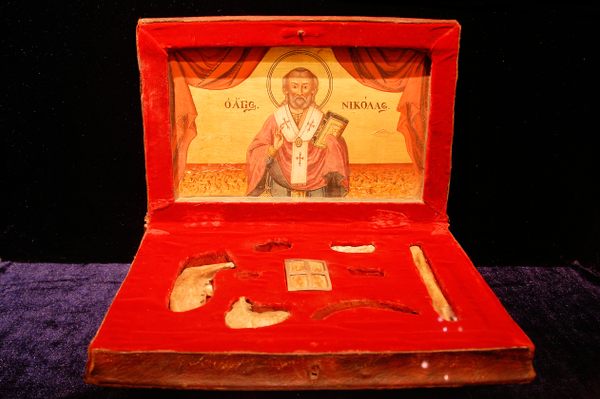Curious Fact of the Week: Saint Valentine, Patron Saint of Lovers, Bee Keepers, Plague, and Epilepsy
Saint Valentine’s holy name may now be inextricably linked to pastel hearts and Hallmark cards, but he’s the patron saint of much more than love. Bee keepers, plague victims, and epilepsy sufferers also fall under his posthumous jurisdiction.
Despite being one of the most known saints, the exact identity of Saint Valentine is itself rather fuzzy. There was a priest named Valentine, as well as a bishop, who were both martyred in the third century by Claudius II after they defended Christians. The priest was beaten to death and decapitated after being imprisoned. The multiple Valentine identities somehow merged, which accounts for the whole horde of Valentine relics, including numerous skulls.
Skull of Saint Valentine in Santa Maria in Cosmedin in Rome (photograph by Lawrence OP)
You might notice that there’s a bit of romance missing from these stories. This is because the source of the courtship and love that has been linked into Valentine’s feast day doesn’t come from the departed saint at all.
According to Alice and Clare La Plante’s Heaven Help Us: The Worrier’s Guide to the Patron Saints:
“The association of Valentine with romantic rites is due to largely futile efforts of early religious Christian leaders to do away with pagan festivals by substituting a Christian observance. February 14 was traditionally the Roman festival of Lupercalia, an important day to honor Juno, the Queen of Heaven and protector of women. The wife of Jupiter, Juno was said to bestow her blessing on courtship rituals or marriages celebrated that day.”
Saint Valentine shrine in Whitefriar Street Carmelite Church in Dublin (photograph by blackfish/Wikimedia)
So Valentine’s Day is more accurately a continuation of Lupercalia shrouded in Catholic appropriation. It also helps that Valentine’s February saint day coincides with the slow dawn of spring when birds are said to select mates. But where do bees, plague, and epilepsy come come in? Well, curing the sick, including epileptics, is one of the miracles attributed to Saint Valentine. In a 2009 paper in Epilepsy & Behavior journal on “St. Valentine–patron saint of epilepsy: illustrating the semiology of seizures over the course of six centuries,” 341 depictions of Valentine curing epilepsy are cited dating back to the 15th century. The plague may have been a later attribution when Europe, struck by the devastating disease, turned to any saint for aid that had any powers of healing. The bee keeping may be more a part of the iconography of fertility attached to Valentine, although sources vary.
To add onto this, Catholic.org mixes in travel, happy marriages, fainting, “greetings,” and engagement to his patronage. It’s clear that whatever Saint Valentine means today is very detached from the lives of the people behind the original saint, but Valentine has long been a reflection of contemporary needs for love and healing rather than any individual.
Read more about the many relics of Saint Valentine.
Curious Facts of the Week: Helping you build your cocktail party conversation repertoire with a new strange fact every week, and an amazing place to explore its story. See all the Curious Facts here>










Follow us on Twitter to get the latest on the world's hidden wonders.
Like us on Facebook to get the latest on the world's hidden wonders.
Follow us on Twitter Like us on Facebook